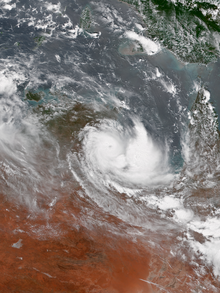 Owen on 13 December around 03:00 UTC at peak intensity | |
| Meteorological history | |
|---|---|
| Formed | 29 November 2018 |
| Dissipated | 20 December 2018 |
| Category 3 severe tropical cyclone | |
| 10-minute sustained (BOM) | |
| Highest winds | 150 km/h (90 mph) |
| Highest gusts | 205 km/h (125 mph) |
| Lowest pressure | 958 hPa (mbar); 28.29 inHg |
| Category 2-equivalent tropical cyclone | |
| 1-minute sustained (SSHWS/JTWC) | |
| Highest winds | 155 km/h (100 mph) |
| Lowest pressure | 965 hPa (mbar); 28.50 inHg |
| Overall effects | |
| Fatalities | 1 |
| Damage | $25 million (2018 USD) |
| Areas affected | Solomon Islands, Papua New Guinea, Queensland, Northern Territory |
| IBTrACS / [1] | |
Part of the 2018–19 Australian region cyclone season | |
Severe Tropical Cyclone Owen was an erratic and long-lived tropical cyclone that affected numerous regions along its track, especially Queensland, in December 2018. Owen was the fourth tropical low, first tropical cyclone, and first severe tropical cyclone of the 2018–19 Australian region cyclone season. Cyclone Owen developed on 29 November 2018 from an area of low pressure that was situated over the Solomon Islands; the system struggled to strengthen in a conflicting environment and degenerated to a tropical low on 3 December. The low drifted westward, and on 9 December, it made its first landfall in Queensland, before moving over the Gulf of Carpentaria, where more favourable conditions allowed it to re-organise. The system regenerated into a tropical cyclone on 12 December and rapidly intensified into a Category 3 severe tropical cyclone that night. At midnight on 13 December, Cyclone Owen made landfall in the Northern Territory, before turning eastward and reaching peak intensity, with sustained winds of 150 km/h (95 mph) and a minimum barometric pressure of 958 hPa (28.3 inHg). On 13 December, Owen made landfall on Queensland again, just north of the mouth of the Gilbert River near Kowanyama. The cyclone weakened rapidly after its third landfall, and the final advisory on Owen was issued on 15 December, after it had degenerated into a tropical low. However, the system persisted over the Coral Sea for another several days, before dissipating on 20 December.
High winds and flooding from Owen caused significant damage along Papua New Guinea's southern coastline. Owen also caused significant rainfall and flooding upon making its first landfall in Queensland. Flooded creeks overwhelmed the Queensland Heritage Register-listed stone bridge, and wind gusts brought down trees in Yarrabah. Owen's effects as a severe tropical cyclone were mostly minor; the Northern Territory received only wind gusts and heavy rain, while some roads in remote areas were cut off, and 2,400 residents in Queensland lost electricity. Effects on inhabited areas around Kowanyama were limited, because Owen made landfall in an uninhabited area and had a small eyewall, which was too small to be distinguished from visible satellite imagery.
Flooding from rainfall was the most severe impact of Owen. After making landfall and crossing the Cape York Peninsula for the final time, Owen brought heavy rainfall to Australia that caused massive flash flooding; Halifax, Queensland received 681 mm (26.8 in) of rain. A mother and her daughter had to be rescued from crocodile-infested floodwaters; a man was swept to death by floods; and a tourist had to be rescued from dangerous ocean swells triggered by the cyclone. Additionally, flooding cut the Bruce Highway north of Ingham. The flooding also had significant effects on the agriculture of North Queensland; around 281 chickens were lost, and sugarcane crops were heavily impacted. The economic impact was estimated to be around AU$32.5 million (US$25 million).[2]
- ^ "Australian Tropical Cyclone Database" (CSV). Australian Bureau of Meteorology. 30 June 2023. Retrieved 30 June 2023. A guide on how to read the database is available here.
- ^ "Weather, Climate & Catastrophe Insight – 2018 Annual Report" (PDF). Aon. Archived from the original (PDF) on 14 February 2019. Retrieved 17 February 2021.